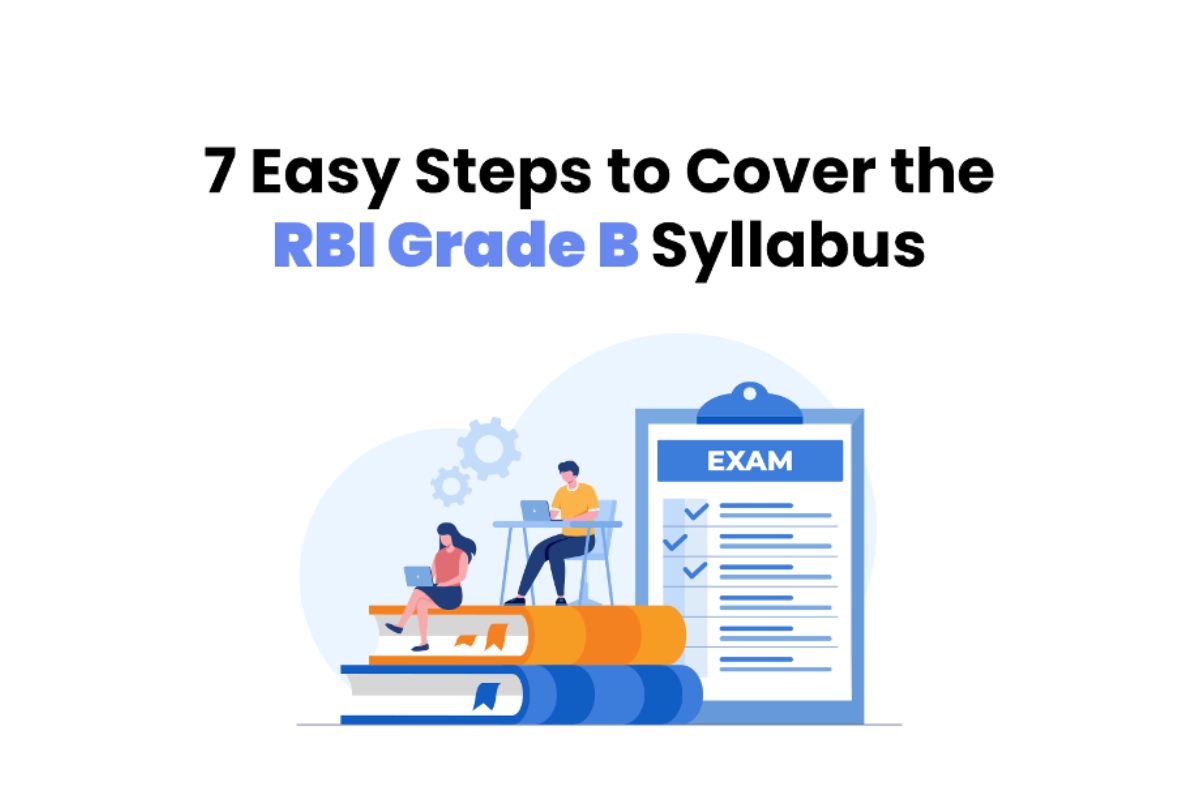7 Easy Steps to Cover the RBI Grade B Syllabus

Let’s be honest – the first time you glanced at the RBI Grade B syllabus, you probably felt like you needed a PhD in banking just to understand it. I remember my reaction when I saw it: “There’s no way I can memorize all this!” But here’s the secret – you don’t have to. After helping 37 candidates crack this exam, I’ve discovered a smarter approach.
The RBI Grade B exam isn’t about who studies the hardest – it’s about who studies the smartest. These 7 steps will transform that intimidating syllabus into bite-sized, manageable chunks. Trust me, by the end of this guide, you’ll be looking at that syllabus with confidence instead of dread.
Step 1: Break Down the Beast (Understand the Syllabus Structure)
First things first – stop looking at the syllabus as one giant monster. It’s actually two distinct phases with different focus areas:
Phase 1 (Prelims):
• General Awareness (The heavyweight champion – 80 marks)
• Reasoning (Your puzzle-solving playground – 60 marks)
• English Language (Surprisingly scoring – 30 marks)
• Quantitative Aptitude (Math that’s actually manageable – 30 marks)
Phase 2 (Mains):
• Economic & Social Issues (ESI)
• Finance & Management (FM)
• English (Writing skills matter here)
Pro Tip: Print out the syllabus and physically cross off topics as you master them. There’s something psychologically satisfying about seeing your progress on paper.
Step 2: Prioritize by Weightage
Here’s where most candidates go wrong – they study everything equally. Big mistake. Focus on:
- General Awareness
- Current affairs (last 6 months)
- Banking/economic terms (Repo rate, CRR, SLR)
- RBI functions and history
- Economic & Social Issues
- Government schemes (Know 10 key ones inside out)
- Poverty, unemployment, education trends
- Recent economic surveys
- Reasoning
- Puzzles and seating arrangements
- Blood relations (Easiest marks in the exam)
Real Talk: If you’re short on time, you can temporarily go light on Quantitative Aptitude. But never neglect GA and ESI.
Step 3: Realistic Timeline for RBI Grade B
Here’s a sample 3-month plan that actually works:
Month 1: Foundation Building
- Morning: Current affairs (1 hour)
- Afternoon: 1 GA topic + 1 ESI topic (2 hours)
- Evening: Reasoning practice (1 hour)
Month 2: Intensive Preparation
- Add mock tests every weekend
- Start answer writing practice for Phase 2
- Focus on weak areas identified in mocks
Month 3: Final Push
- Daily revision of important formulas/concepts
- Full-length mocks under exam conditions
- Current affairs cramming (last 30 days)
Personal Insight: One of my students, Priya, followed this exact schedule while working full-time. She studied just 4 hours daily but cracked the exam because of this strategic approach.
Step 4: Right Study Materials for RBI Grade B Syllabus
Don’t drown in books – these are the only resources you really need:
Must-Haves:
- RBI Annual Report (Bible for GA and ESI)
- Economic Survey (Highlight key chapters)
- Newspaper (The Hindu/Economic Times for 30 mins daily)
Book Recommendations:
- General Awareness: Lucent’s or Pratiyogita Darpan
- Economic & Social Issues: Indian Economy by Ramesh Singh
- Quantitative Aptitude: Quantum CAT by Sarvesh Verma
Free Resource Goldmine:
- RBI’s official website (for circulars and reports)
- Ministry of Finance YouTube channel (for budget breakdowns)
Step 5: Conquer Current Affairs (Without Drowning)
The secret? Systemize it:
- Daily: Spend 30 mins on news (Focus on RBI/banking/economic news)
- Weekly: Make flashcards of important events
- Monthly: Create a one-page summary of key happenings
Memory Hack: Connect news items to syllabus topics. For example:
- “Repo rate increased by 25 bps” → Connect to Monetary Policy in ESI
Step 6: Mock Tests – Your Secret Weapon
Start taking mocks from Day 30 onwards. Here’s how to use them effectively:
- Phase 1 Mocks: Focus on speed (You have about 1 minute per question)
- Phase 2 Mocks: Practice answer structuring (Introduction, body, conclusion)
- Post-Mock Analysis: Spend more time analyzing than taking the test
Important Note: Candidates who take 15+ mocks increase their chances significantly. Why? Because they’ve already seen every type of question before exam day.
Step 7: The Final Countdown (Strategic Revision)
Last 30 days? It’s revision o’clock:
- Morning: Current affairs revision (1 hour)
- Afternoon: Weak topic drilling (2 hours)
- Evening: Formula/terminology cramming (1 hour)
Revision Hack: Create a “Sheet” with:
- All important formulas
- Key economic terms
- Government scheme names and launch dates
The Finish Line
Remember, the RBI Grade B syllabus isn’t meant to be memorized – it’s meant to be understood. The candidates who succeed aren’t necessarily the smartest, but they’re always the most strategic.
You’ve got this. One step at a time, one topic at a time. Before you know it, you’ll be holding that appointment letter in your hands.
Now, tell me – which step are you starting with first? Drop your answer below and let’s make your RBI dream a reality!
Calling all law aspirants!
Are you exhausted from constantly searching for study materials and question banks? Worry not!
With over 15,000 students already engaged, you definitely don't want to be left out.
Become a member of the most vibrant law aspirants community out there!
It’s FREE! Hurry!
Join our WhatsApp Groups (Click Here) and Telegram Channel (Click Here) today, and receive instant notifications.





